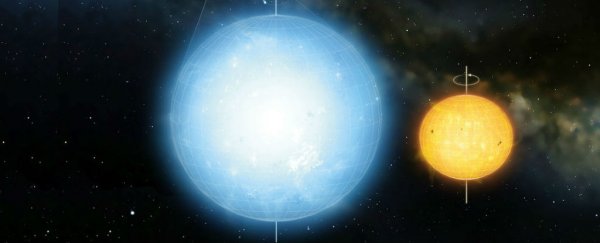Geometry is everywhere in nature - we see sixfold symmetry in snowflakes, fractal patterns in broccoli, and Fibonacci spirals in red cabbage. But a perfectly formed sphere? That's a whole lot harder to find.
While all those moons, stars, and planets out in space appear to be pretty round, the reality is they're getting flattened, squished, and skewed with every rotation on their axis. But scientists have managed to find a star so round, it's the most spherical object in the known Universe.
The star in question is called Kepler 11145123 (or KIC 11145123), located some 5,000 light-years from Earth.
When a team led by astronomer Laurent Gizon from Max Planck Institute for Solar System Research and the University of Göttingen in Germany first discovered it, they used a technique called asteroseismology to determine how spherical it is.
Strangely enough, this slowly rotating gas sphere hasn't been flattened as it spins on its axis - its roundness is so beautifully intact, the researchers say it's the most spherical natural object known to science.
"[K]epler 11145123 the roundest natural object ever measured, even more round than the Sun," says Gizon.
The discovery has opened up a whole bunch of questions - mainly how on Earth did this thing get so round - but let's run through what we do know about nature's most spherical object.
The technique of asteroseismology allows researchers to calculate the oscillation of stars, and use that to figure out its oblateness - basically how much flattening or compression a circle or sphere has.
When stars, planets, and moons spin on their axis, they experience centrifugal forces, which pull their equatorial regions away from the centre of rotation. This causes these round objects to end up slightly more wide than they are tall - or 'oblate'.
The faster a cosmic body spins, the more oblate it becomes, but KIC 11145123 is a particularly slow spinner.
The researchers calculate that it spins three times more slowly than our Sun, but is more than twice the size.
In terms of exact measurements of 'roundness', they calculated that the difference between the equatorial and polar radii of the star is only 3 km - "a number that is astonishing small compared to the star's mean radius of 1.5 million km; which means that the gas sphere is astonishingly round", they report.
To put those numbers into perspective, our Sun has a radius at the equator that is 10 km larger than at the poles, and for our lumpy old Earth, this difference is 21 km.
But things don't really add up, because the team says KIC 11145123 is even less flattened than implied by its slow rotation rate.
As Michael Byrne explains for Motherboard, asteroseismology is based on our ability to separate out the frequencies of acoustic waves emanating from a star's interior.
"Using these waves to visualise the guts of the star, they found that KIC 11145123's exterior layers are rotating faster than its core," says Byrne.
"This is what is likely causing the unusually round (or less 'oblate') shape - because of the disconnect between surface and core, the star is not spinning quite as much as may appear just by looking at it from the outside."
It's not clear what's causing this disconnect between the surface and core spin rates, but the researchers suggest that the presence of a magnetic field a low latitudes around the star could be the culprit.
"Other than a magnetic field, there are few alternative explanations for the reduced oblateness," the researchers conclude. "At this level of precision, the physics of stellar oscillations may need to be studied in more detail."
The team plans on using the technique on other stars in the future, to see how rotations and magnetic fields can influence their shapes.
The study has been published in Science Advances.
